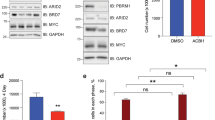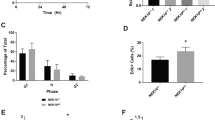Abstract
P14/p19ARF (ARF) plays a major role in the activation of p53 by oncogenic signals. The biochemical basis of this has not been fully elucidated. We report here that forced expression of p14ARF enhances phosphorylation of p53 serine 15 (p53S15) in NIH3T3, IMR90 and MCF7 cells. Ectopic expression of the oncogenes c-myc, E2F1 and E1A, all of which activate p53 at least partially via ARF, lead to p53S15 phosphorylation in IMR90 cells. In addition, ectopic expression of p53 also results in p53S15 phosphorylation, suggesting that this is a common event in the ARF–p53 tumor suppression system. Furthermore, p53-, p14ARF-, c-myc- and E2F1-, but not E1A-, induced p53S15 phosphorylation was substantially reduced in AT fibroblasts (GM05823). Downregulation of ATM in MCF7 cells using RNA interference (RNAi) technology significantly attenuated p14ARF- and p53-induced phosphorylation of p53S15. Ectopically expressed ARF in NIH3T3 cells induced ATM nuclear foci and activated ATM kinase. Functionally, ectopic expression of p14ARF and c-myc inhibited the proliferation of IMR90 but not ATM null GM05823 cells, and p14ARF-induced inhibition of MCF7 cell proliferation was significantly attenuated by downregulation of ATM by RNAi. Taken together, these data show a functional role for ATM in ARF-mediated tumor suppression.
This is a preview of subscription content, access via your institution
Access options
Subscribe to this journal
Receive 50 print issues and online access
$259.00 per year
only $5.18 per issue
Buy this article
- Purchase on Springer Link
- Instant access to full article PDF
Prices may be subject to local taxes which are calculated during checkout







Similar content being viewed by others
References
Bakkenist CJ and Kastan MB . (2003). Nature, 421, 499–506.
Bates S, Phillips AC, Clark PA, Stott F, Peters G, Ludwig RL and Vousden KH . (1998). Nature, 395, 124–125.
Burri N, Shaw P, Bouzourene H, Sordat I, Sordat B, Gillet M, Schorderet D, Bosman FT and Chaubert P . (2001). Lab. Invest., 81, 217–229.
Chan DW, So SC, Block W, Ye R, Khanna KK, Wold MS, Douglas P, Goodarzi AA, Pelley J, Taya Y, Lavin MF and Lees-Miller SP . (2000). J. Biol. Chem., 275, 7803–7810.
Chehab NH, Malikzay A, Stavridi ES and Halazonetis TD . (1999). Proc. Natl. Acad. Sci. USA, 96, 13777–13782.
Cong F, Zou X, Hinrichs K, Calame K and Goff SP . (1999). Oncogene, 18, 7731–7739.
Damalas A, Kahan S, Shtutman M, Ben Ze’ev A and Oren M . (2001). EMBO J., 20, 4912–4922.
de Stanchina E, McCurrach ME, Zindy F, Shieh SY, Ferbeyre G, Samuelson AV, Prives C, Roussel MF, Sherr CJ and Lowe SW . (1998). Genes. Dev., 12, 2434–2442.
Dimri GP, Itahana K, Acosta M and Campisi J . (2000). Mol. Cell Biol., 20, 273–285.
Eischen CM, Weber JD, Roussel MF, Sherr CJ and Cleveland JL . (1999). Genes. Dev., 13, 2658–2669.
Hirao A, Kong YY, Matsuoka S, Wakeham A, Ruland J, Yoshida H, Liu D, Elledge SJ and Mak TW . (2000). Science, 287, 1824–1827.
Ho GH, Calvano JE, Bisogna M, Abouezzi Z, Borgen PI, Cordon-Cardo C and van Zee KJ . (2001). Breast Cancer Res. Treat., 65, 225–232.
Honda R, Tanaka H and Yasuda H . (1997). FEBS Lett., 420, 25–27.
Honda R and Yasuda H . (1999). EMBO J., 18, 22–27.
Ichimura K, Bolin MB, Goike HM, Schmidt EE, Moshref A and Collins VP . (2000). Cancer Res., 60, 417–424.
Inoue K, Roussel MF and Sherr CJ . (1999). Proc. Natl. Acad. Sci. USA, 96, 3993–3998.
Ito A, Lai CH, Zhao X, Saito S, Hamilton MH, Appella E and Yao TP . (2001). EMBO J., 20, 1331–1340.
Jin S and Levine AJ . (2001). J. Cell Sci., 114, 4139–4140.
Jones SN, Roe AE, Donehower LA and Bradley A . (1995). Nature, 378, 206–208.
Kamijo T, van de Kamp E, Chong MJ, Zindy F, Diehl JA, Sherr CJ and McKinnon PJ . (1999). Cancer Res., 59, 2464–2469.
Kamijo T, Weber JD, Zambetti G, Zindy F, Roussel MF and Sherr CJ . (1998). Proc. Natl. Acad. Sci. USA, 95, 8292–8297.
Kamijo T, Zindy F, Roussel MF, Quelle DE, Downing JR, Ashmun RA, Grosveld G and Sherr CJ . (1997). Cell, 91, 649–659.
Kashuba E, Mattsso K, Klein G and Szekel L . (2003). Mol. Cancer, 2, 18.
Khan SH, Moritsugu J and Wahl GM . (2000). Proc. Natl. Acad. Sci. USA, 97, 3266–3271.
Llanos S, Clark PA, Rowe J and Peters G . (2001). Nat. Cell Biol., 3, 445–452.
Lyakhovich A and Shekhar MP . (2003). Mol. Cell Biol., 23, 2463–2475.
Michael D and Oren M . (2002). Curr. Opin. Genet. Dev., 12, 53–59.
Momand J, Zambetti GP, Olson DC, George D and Levine AJ . (1992). Cell, 69, 1237–1245.
Montes de Oca LR, Wagner DS and Lozano G . (1995). Nature, 378, 203–206.
Olivier A, Lucie K, Jean-Francois R, Christian-Jacques L and Paule S . (2003). Oncogene, 22, 1945–1954.
Palmero I, Pantoja C and Serrano M . (1998). Nature, 395, 125–126.
Quelle DE, Zindy F, Ashmun RA and Sherr CJ . (1995). Cell, 83, 993–1000.
Raveh T, Droguett G, Horwitz MS, DePinho RA and Kimchi A . (2001). Nat. Cell Biol., 3, 1–7.
Rogoff HA, Pickering MT, Debatis ME, Jones S and Kowalik TF . (2002). Mol. Cell Biol., 22, 5308–5318.
Roth J, Dobbelstein M, Freedman DA, Shenk T and Levine AJ . (1998). EMBO J., 17, 554–564.
Russell JL, Powers JT, Rounbehler RJ, Rogers PM, Conti CJ and Johnson DG . (2002). Mol. Cell Biol., 22, 1360–1368.
Serrano M, Hannon GJ and Beach D . (1993). Nature, 366, 704–707.
Serrano M, Lin AW, McCurrach ME, Beach D and Lowe SW . (1997). Cell, 88, 593–602.
Shieh SY, Ikeda M, Taya Y and Prives C . (1997). Cell, 91, 325–334.
Shintani S, Nakahara Y, Mihara M, Ueyama Y and Matsumura T . (2001). Oral Oncol., 37, 498–504.
Stott FJ, Bates S, James MC, McConnell BB, Starborg M, Brookes S, Palmero I, Ryan K, Hara E, Vousden KH and Peters G . (1998). EMBO J., 17, 5001–5014.
Sugimoto M, Kuo ML, Roussel MF and Sherr CJ . (2003). Mol. Cell, 11, 415–424.
Tang D, Chun AC, Zhang M and Wang JH . (1997). J. Biol. Chem., 272, 12318–12327.
Tang D, Wu D, Hirao A, Lahti JM, Liu L, Mazza B, Kidd VJ, Mak TW and Ingram AJ . (2002). J. Biol. Chem., 277, 12710–12717.
Tibbetts RS, Cortez D, Brumbaugh KM, Scully R, Livingston D, Elledge SJ and Abraham RT . (2000). Genes Dev., 14, 2989–3002.
Vafa O, Wade M, Kern S, Beeche M, Pandita TK, Hampton GM and Wahl GM . (2002). Mol. Cell., 9, 1031–1044.
Watanabe T, Nakamura M, Yonekawa Y, Kleihues P and Ohgaki H . (2001). Acta Neuropathol (Berl)., 101, 185–189.
Weber JD, Taylor LJ, Roussel MF, Sherr CJ and Bar-Sagi D . (1999). Nat. Cell Biol., 1, 20–26.
Wu D, Ingram AJ, Lahti JH, Mazza B, Grenet J, Kapoor A, Liu L, Kidd VJ and Tang D . (2002). J. Biol. Chem., 277, 12001–12008.
Yin Y, Stephen CW, Luciani MG and Fahraeus R . (2002). Nat. Cell Biol., 4, 462–467.
Zhang Y and Xiong Y . (1999). Mol. Cell, 3, 579–591.
Zhou BB and Elledge SJ . (2000). Nature, 408, 433–439.
Zindy F, Eischen CM, Randle DH, Kamijo T, Cleveland JL, Sherr CJ and Roussel MF . (1998). Genes Dev., 12, 2424–2433.
Acknowledgements
We thank Drs Joseph R Nevins of Duke University and Frank Graham of McMaster University for providing E2F1 and E1A, respectively. This work was supported in part by the National Cancer Institute of Canada (grant no. 13009 200), a grant of Kidney Foundation of Canada, Canadian Foundation for Innovation (grant no. 6987) all to DT and a grant from the Canadian Institutes of Heath Research to AI. We like to dedicate this work to Dr Vincent J Kidd, member (professor) of St Jude Children's Research Hospital, who suddenly passed away on May 7, 2004.
Author information
Authors and Affiliations
Corresponding author
Rights and permissions
About this article
Cite this article
Li, Y., Wu, D., Chen, B. et al. ATM activity contributes to the tumor-suppressing functions of p14ARF. Oncogene 23, 7355–7365 (2004). https://doi.org/10.1038/sj.onc.1207957
Received:
Revised:
Accepted:
Published:
Issue Date:
DOI: https://doi.org/10.1038/sj.onc.1207957
Keywords
This article is cited by
-
Functional interplay between the DNA-damage-response kinase ATM and ARF tumour suppressor protein in human cancer
Nature Cell Biology (2013)
-
ARF triggers cell G1 arrest by a P53 independent ERK pathway
Molecular and Cellular Biochemistry (2011)
-
PTEN inhibits BMI1 function independently of its phosphatase activity
Molecular Cancer (2009)
-
Tumour suppression by p53: a role for the DNA damage response?
Nature Reviews Cancer (2009)
-
Cooperative effect of p21Cip1/WAF−1 and 14-3-3σ on cell cycle arrest and apoptosis induction by p14ARF
Oncogene (2008)



